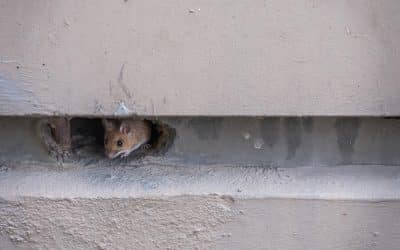
Pest Identification: Mice
Mice are common yet unwelcome guests in homes, exhibiting behaviors and characteristics that are both intriguing and problematic. They typically live for 12 to 18 months, but indoors, with abundant food, water, and shelter, they can live up to two or three years. They are also skilled chewers, damaging materials like drywall, wood, carpeting, and electrical wires. Their ability to squeeze through tiny openings, as small as a pencil's width, and create new entry points makes them formidable intruders.
Mice can survive in remarkably small areas with limited amounts of food and shelter, so mouse control can be straightforward if you know what to look for and what to do. If you suspect you have mice issues, look for gnawed areas, tiny mouse droppings that look like dark grains of rice, and tracks in dust, snow around foundations, and dirt. Their constant gnawing can cause extensive household damage and are a huge fire risk as they like to gnaw on wiring covered with insulation. According to Gordon E. Ivory, CFEI, CVFI, CFII, RL (Certified Fire and Explosion Investigator) Up to 20% of undetermined fires are believed to be caused by rodents chewing on wires.
Effects from mouse droppings and urine can also lead to serious illnesses in people, such as salmonella and Hantavirus. One mouse can leave a staggering 3000 droplets of urine and 40-60 droppings per day.
However, the most effective mice control starts with good sanitation – cleaning and properly maintaining food storage areas so they don’t attract mice. In fact, all places where food is stored, processed, or used should be made mouse-proof so that mouse control is more efficient from the start. That means sealing up any holes or openings larger than a quarter of an inch, paying special attention to foundations, pipe openings, vents, and other points of entry to the indoors. Good mouse control is helped considerably by the proper sealing of these kinds of external access points.
Signs of a mouse infestation include droppings, gnaw marks, footprints, rub marks, established runways, and sightings. Homeowners should be vigilant in recognizing these signs for early intervention.
Mice are adaptable, staying indoors year-round and becoming noticeable during fall migration. They can squeeze into tiny holes, hoard various items, and chew through various materials. Mice are also good jumpers, climbers, and swimmers, often traveling along walls and edges.
Recognizing infestation signs is crucial for prompt and effective control measures. Mice control and mice management are service specialties here at Ford’s.

Buzzwords
Give Your House a Winter Check-Up and Keep Pests, Mice, and Wildlife Out
Winter is officially here, and while you’re getting yourself ready for the cold, don’t forget your home needs a little winter prep, too. Think of it like your home’s annual check-up: a quick once-over to make sure everything is in good shape before pests start looking...
How Mice Sneak Into Your Home (And What You Can Do About It)
Your home feels extra cozy in the winter, with warm blankets, soft lighting, and maybe even a fire on chilly nights. But while you’re settling in, mice are out there searching for a warm place to hide. For many Massachusetts homeowners, that means your house is at...
Serving Food, Not Pests: What Restaurants Need to Know
Pests and restaurants don’t mix. When you run a popular food establishment, everyone loves to stop in for a bite. Including unwanted pests. Even a small pest problem can threaten your health inspections, damage your reputation, and cost you customers. At Ford’s...



